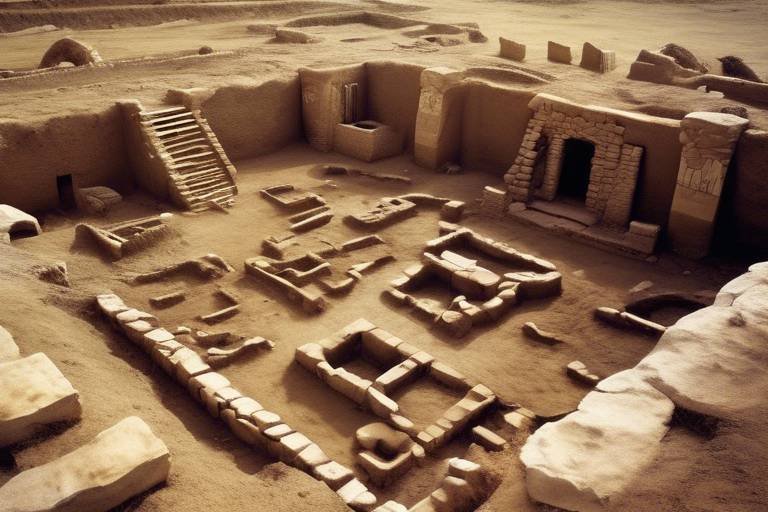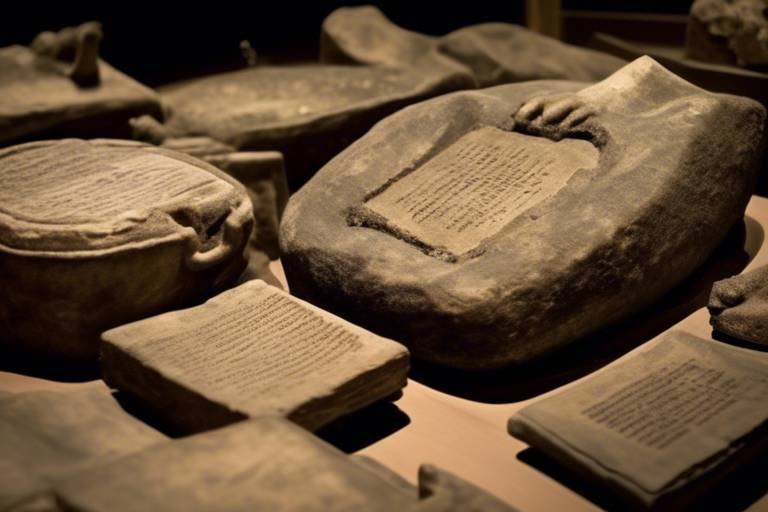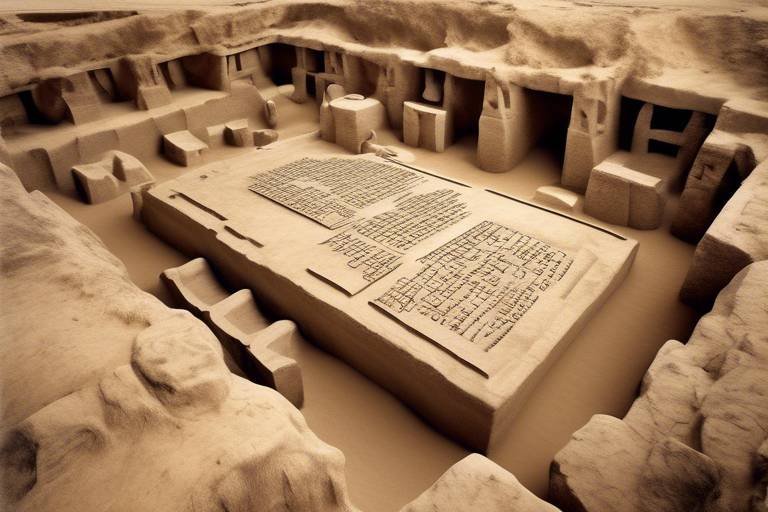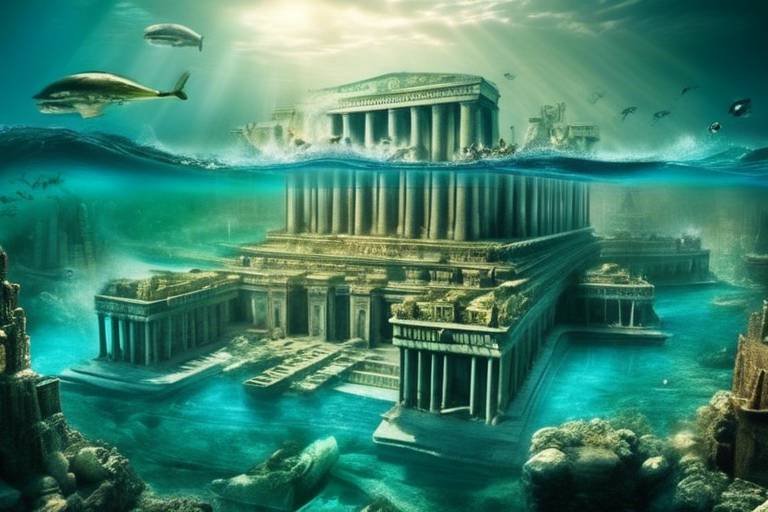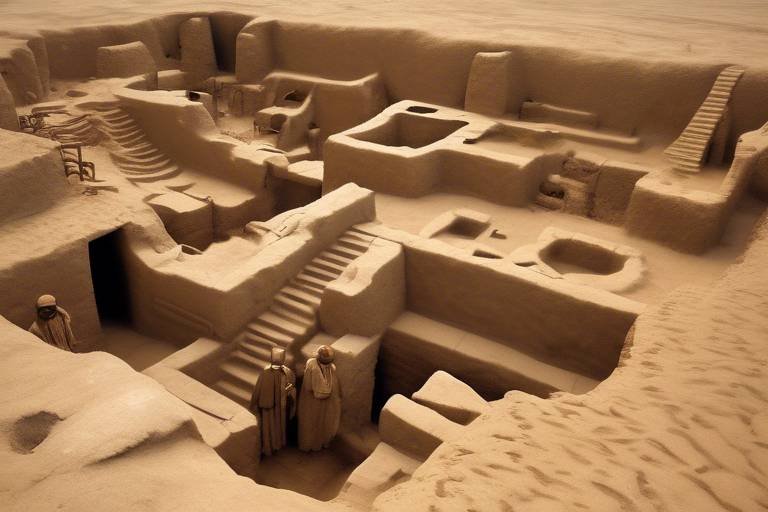The Influence of Religion on Ancient Art
Religion played a profound role in shaping the art of ancient civilizations, serving as a powerful source of inspiration and expression for artists throughout history. The intertwining of religious beliefs with artistic endeavors resulted in a rich tapestry of cultural heritage that continues to captivate and intrigue us today.
Ancient Egyptian art stands as a testament to the deep spiritual connection of the civilization with their gods and the afterlife. Monumental sculptures, intricate hieroglyphics, and vivid tomb paintings vividly depict the divinity of pharaohs, the pantheon of gods, and the journey to the underworld, offering a glimpse into the mystical beliefs and rituals of the ancient Egyptians.
Greek mythology, with its pantheon of gods and epic tales of heroes, found expression in various art forms such as marble statues, pottery, and temple friezes. These artistic representations not only showcased the artistic prowess of the Greeks but also served as visual narratives of their religious beliefs and cultural values, immortalizing the myths for generations to come.
Hindu iconography, with its intricate sculptures and vibrant paintings, beautifully captures the essence of deities like Vishnu, Shiva, and Devi, embodying divine attributes and stories from ancient scriptures. Each artistic creation serves as a visual hymn to the gods, inviting devotees into a world of spiritual contemplation and devotion.
Buddhist art, characterized by serene statues, intricate mandalas, and mesmerizing cave paintings, reflects the teachings of Buddha and Bodhisattvas. These artistic expressions not only convey profound spiritual messages but also serve as tools for meditation and enlightenment, guiding followers on the path to inner peace and awakening.
Mayan religious symbols, intricately depicted through glyphs, stelae, and ceramics, offer a glimpse into the complex cosmology and religious worldview of ancient Mesoamerica. Each symbol and artwork unveils a piece of the intricate tapestry of Mayan beliefs, rituals, and deities, inviting us to unravel the mysteries of this ancient civilization.
Christian iconography, manifested in frescoes, mosaics, and illuminated manuscripts, portrays biblical narratives, saints, and angels with divine beauty and reverence. Through intricate artistic creations, medieval artists conveyed the teachings of Christianity and inspired devotion among the faithful, creating a visual language of faith and spirituality.
Islamic art, characterized by exquisite calligraphy and intricate geometric patterns, adorns mosques, palaces, and manuscripts with divine beauty and unity. Quranic verses and symbolic motifs not only decorate the physical spaces but also serve as a reflection of the profound spiritual beliefs and aesthetic sensibilities of Islamic culture.
Shinto shrine art, featuring kami spirits, torii gates, and ema votive tablets, embodies the reverence for nature and ancestral spirits in Japanese culture. Through paintings and sculptures, Shinto artists capture the essence of spiritual connection with the natural world, inviting viewers to immerse themselves in the beauty and mystique of Shinto beliefs.

Ancient Egyptian Art
Ancient Egyptian art stands as a testament to the profound influence of religion on artistic expression. From colossal statues to intricate hieroglyphics, the art of this civilization is a window into their spiritual beliefs and practices. The Egyptians believed in a pantheon of gods and the concept of an afterlife, which heavily influenced their artistic creations.
One of the most iconic forms of ancient Egyptian art is the monumental sculptures of pharaohs and gods. These imposing statues were not just artistic representations but were believed to house the divine essence of the depicted figures. The intricate hieroglyphics found in temples and tombs served as both written language and sacred symbols, conveying stories of the gods and rituals for the afterlife.
The vivid tomb paintings of ancient Egypt also reflect their religious beliefs. These elaborate murals depicted scenes from the journey to the afterlife, the judgment of the soul, and the eternal life in the Field of Reeds. Each artwork was created with meticulous detail and symbolic meaning, emphasizing the Egyptians' deep connection to the divine and their reverence for the spiritual realm.
Ancient Egyptian art not only captured the visual beauty of their religious beliefs but also served a practical purpose in ensuring the continuity of the soul in the afterlife. The intricate rituals and mythologies of ancient Egypt were intricately woven into every artistic creation, making art an integral part of their religious and cultural identity.

Greek Mythology in Art
Exploring how religious beliefs shaped the art of ancient civilizations, reflecting spiritual practices, rituals, and mythologies in various forms of artistic expression.
The art of ancient Greece is deeply intertwined with the rich tapestry of Greek mythology, where gods and heroes come to life through marble statues, pottery, and temple friezes. These artistic creations serve as visual narratives that not only entertain but also educate about the religious beliefs and cultural values of the ancient Greeks.
Imagine walking through the ancient streets of Athens, surrounded by towering statues of Zeus and Athena, each intricately carved to capture the essence of divine power and beauty. These sculptures not only honor the gods but also serve as a reminder of the importance of piety and respect for the divine in Greek society.
Moreover, the intricate designs on pottery tell the stories of mythical battles and heroic deeds, bringing to life the epic tales of gods and mortals. Each vase is a canvas of artistic expression, blending mythology with everyday life, offering a glimpse into the religious practices and beliefs of the ancient Greeks.
Temple friezes adorned with scenes from mythology serve as a visual representation of the Greeks' reverence for their gods. These elaborate carvings depict stories of creation, heroism, and tragedy, inviting worshippers to reflect on the divine mysteries and moral lessons embedded in these ancient tales.
Through the art of Greek mythology, artists not only captured the essence of the divine but also celebrated the human experience, weaving together the realms of gods and mortals in a harmonious tapestry of creativity and spirituality.
- How did religion influence ancient art?
- What role did mythology play in Greek art?
- How did different civilizations incorporate religious themes in their art?
Religion served as a primary source of inspiration for ancient artists, shaping their artistic expressions and subject matter. Whether depicting gods, rituals, or mythological stories, art was a means of honoring the divine and conveying spiritual beliefs.
Greek mythology was a central theme in ancient Greek art, serving as a means of educating and engaging viewers with the stories of gods and heroes. Mythological narratives were depicted in various art forms, reflecting the religious beliefs and cultural values of the ancient Greeks.
Various ancient civilizations, such as the Egyptians, Greeks, Hindus, Buddhists, Mayans, Christians, Muslims, and Shintoists, each integrated religious themes into their art in unique ways. From monumental sculptures to intricate paintings, art served as a medium for expressing devotion, spirituality, and cultural identity.

Hindu Iconography
Hindu Iconography plays a significant role in the rich tapestry of Hindu art, capturing the essence of the divine through intricate sculptures and vibrant paintings. Each deity, such as Vishnu, Shiva, and Devi, is depicted with symbolic attributes and poses that convey their divine qualities and stories from ancient scriptures. These artistic representations serve not only as visual aids but also as a means of connecting with the spiritual realm and deepening one's understanding of the Hindu pantheon.

Buddhist Art
Exploring how religious beliefs shaped the art of ancient civilizations, reflecting spiritual practices, rituals, and mythologies in various forms of artistic expression.
Depicting gods, pharaohs, and the afterlife in monumental sculptures, hieroglyphics, and tomb paintings, showcasing a deep connection to the divine.
Interpreting myths of gods and heroes through marble statues, pottery, and temple friezes, illustrating the Greeks' religious beliefs and cultural values.
Representing deities like Vishnu, Shiva, and Devi in intricate sculptures and paintings, embodying divine attributes and stories from ancient scriptures.
Expressing teachings of Buddha and Bodhisattvas through serene statues, mandalas, and cave paintings, fostering spiritual contemplation and enlightenment.
Utilizing glyphs, stelae, and ceramics to depict gods, rituals, and cosmology, revealing a complex religious worldview in ancient Mesoamerica.
Portraying biblical narratives, saints, and angels in frescoes, mosaics, and illuminated manuscripts, conveying religious teachings and devotion in medieval art.
Incorporating Quranic verses and geometric patterns in mosques, palaces, and manuscripts, symbolizing divine unity and beauty in Islamic art.
Featuring kami spirits, torii gates, and ema votive tablets in paintings and sculptures, embodying reverence for nature and ancestral spirits in Japanese art.
Buddhist art is a profound reflection of the teachings of Buddha and the spiritual journey towards enlightenment. Through serene statues, intricate mandalas, and mesmerizing cave paintings, Buddhist art serves as a visual medium for contemplation and inner peace.

Mayan Religious Symbols
Mayan religious symbols hold a profound significance in understanding the spiritual beliefs and practices of the ancient Mesoamerican civilization. Through the use of glyphs, stelae, and ceramics, the Mayans depicted their gods, rituals, and cosmology, offering a glimpse into their complex religious worldview.
The intricate glyphs served as a form of writing, representing not only language but also sacred symbols and historical events. These glyphs adorned temples, monuments, and codices, providing a visual language for communicating religious narratives and celestial knowledge.
Stelae, large stone slabs carved with intricate designs and hieroglyphs, were erected to commemorate important events, such as royal successions, military victories, and religious ceremonies. These monuments served as a connection between the earthly realm and the divine, embodying the spiritual essence of the Mayan civilization.
Ceramics played a crucial role in Mayan religious practices, with vessels and figurines often adorned with symbolic motifs and representations of deities. These intricate artworks were used in rituals, ceremonies, and burials, symbolizing the interconnectedness between the material world and the spiritual realm.
Overall, Mayan religious symbols not only served as artistic expressions but also as conduits for spiritual communication and reverence. The intricate details and symbolic meanings embedded in these artifacts offer a glimpse into the rich tapestry of Mayan religious beliefs and practices.

Christian Iconography
Exploring how religious beliefs shaped the art of ancient civilizations, reflecting spiritual practices, rituals, and mythologies in various forms of artistic expression.
Christian iconography is a fascinating realm within the art world that has long been cherished for its portrayal of biblical narratives, saints, and angels. In medieval art, frescoes, mosaics, and illuminated manuscripts served as powerful mediums to convey religious teachings and inspire devotion among the faithful.
The intricate details in these artworks, from the golden halos symbolizing holiness to the flowing robes depicting purity, all aimed to bring the divine closer to the viewer. Each stroke of the brush or chisel was dedicated to capturing the essence of spiritual stories and figures, making them tangible and relatable.
Imagine walking into a grand cathedral adorned with vibrant frescoes depicting scenes from the Bible. The colors dance on the walls, telling stories of miracles, martyrdom, and salvation. Every image, every figure, invites contemplation and reverence, drawing worshippers into a deeper connection with their faith.
Christian iconography not only served as a visual representation of religious narratives but also as a form of spiritual meditation. The act of creating these artworks was seen as a form of devotion, with artists pouring their hearts and souls into each piece to honor their beliefs and inspire awe in others.
Through the use of symbols, colors, and composition, Christian iconography transcended mere artistic expression to become a powerful tool for conveying the mysteries of faith. The interplay of light and shadow, the delicate brushstrokes, and the intricate details all worked together to create a sacred space where the divine and the earthly intertwined.
From the humblest of chapels to the grandest of cathedrals, Christian iconography has left an indelible mark on the art world, reminding us of the enduring power of faith and the timeless beauty of spiritual expression.

Islamic Calligraphy and Architecture
Islamic art is renowned for its exquisite calligraphy and architecture, which play a significant role in expressing the beauty and unity of Islamic beliefs. Calligraphy, with its intricate Quranic verses and elegant script, is not merely decorative but holds deep spiritual significance. Every stroke of the pen is a reflection of devotion and reverence for the sacred text. Similarly, Islamic architecture is characterized by its grand mosques, intricate geometric patterns, and majestic domes. These architectural marvels symbolize the divine unity and beauty found in Islamic teachings, creating spaces that inspire awe and contemplation.

Shinto Shrine Art
Shinto Shrine Art holds a unique place in the realm of artistic expression, embodying the spiritual essence of Shinto beliefs through visual representations. The artworks found in Shinto shrines are not merely decorative; they serve as vessels of reverence, connecting the physical world with the divine realm. These artistic creations often depict kami spirits, revered deities in Shintoism, in various forms such as paintings and sculptures.
One of the most iconic elements of Shinto Shrine Art is the torii gate, symbolizing the transition from the mundane to the sacred. These gates mark the entrance to sacred spaces and are often adorned with intricate carvings and vibrant colors, inviting visitors to step into a realm where the spiritual and earthly realms converge.
Ema votive tablets are another significant aspect of Shinto Shrine Art, where worshippers write their prayers and wishes on wooden plaques and hang them at the shrine. These tablets serve as tangible expressions of devotion and gratitude, creating a visual tapestry of hopes and aspirations within the sacred space.
Shinto Shrine Art not only celebrates the natural world but also pays homage to ancestral spirits, honoring the interconnectedness of past, present, and future. The artworks found in Shinto shrines are not static representations but living expressions of a vibrant spiritual tradition that continues to evolve and inspire.
Frequently Asked Questions
- What is the significance of religion in ancient art?
Religion played a crucial role in shaping ancient art, serving as a medium to express spiritual beliefs, mythologies, and cultural values of civilizations.
- How did ancient Egyptian art reflect religious beliefs?
Ancient Egyptian art depicted gods, pharaohs, and the afterlife, showcasing a deep connection to the divine through monumental sculptures, hieroglyphics, and tomb paintings.
- What themes were commonly portrayed in Greek mythology through art?
Greek mythology was often interpreted through marble statues, pottery, and temple friezes, illustrating stories of gods and heroes that reflected religious beliefs and cultural values.
- What is Hindu iconography and how did it influence art?
Hindu iconography represents deities like Vishnu, Shiva, and Devi through intricate sculptures and paintings, embodying divine attributes and stories from ancient scriptures.
- How did Buddhist art contribute to spiritual contemplation?
Buddhist art expressed teachings of Buddha and Bodhisattvas through serene statues, mandalas, and cave paintings, fostering spiritual contemplation and enlightenment.
- What were the key features of Mayan religious symbols in art?
Mayan religious symbols utilized glyphs, stelae, and ceramics to depict gods, rituals, and cosmology, revealing a complex religious worldview in ancient Mesoamerica.
- How did Christian iconography convey religious teachings in medieval art?
Christian iconography portrayed biblical narratives, saints, and angels in frescoes, mosaics, and illuminated manuscripts, conveying religious teachings and devotion.
- What is the significance of Islamic calligraphy in art?
Islamic calligraphy incorporated Quranic verses and geometric patterns in mosques, palaces, and manuscripts, symbolizing divine unity and beauty in Islamic art.
- What elements are featured in Shinto Shrine art?
Shinto Shrine art features kami spirits, torii gates, and ema votive tablets in paintings and sculptures, embodying reverence for nature and ancestral spirits in Japanese art.



